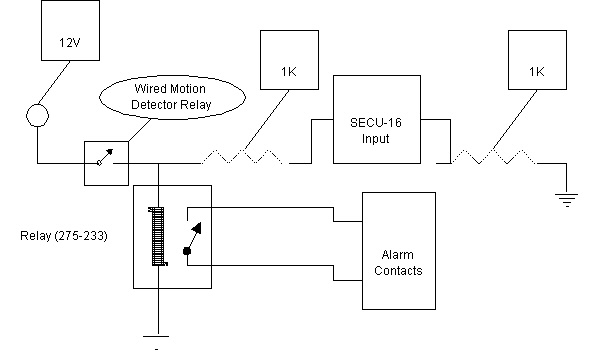
Motion detectors are used throughout the house to 'see' where the action is so if it is dark outside, the lights will turn on automatically (Home Automation...). (Click here to see how we program with the motion detectors.)
After getting 22 X10 motion detectors (with built in light sensors) in the system, I found they had a tendency to walk on each other. If more than one detector detected motion at once, they would both attempt to report it at the same time. There were problems with the RF side and the X10 side. I didn't do a whole bunch of troubleshooting to find out exactly which bothered the system more but I did create a very nice solution with the motion detectors that were installed and already wired to the alarm (right next to Mary).
The biggest problem with using the motion detectors from the alarm was isolating the alarm from the SECU-16. Since the alarm only needed a relay closure (and that being the only thing it could detect), I figured I could re-create that contact closure with a relay. The contact closure in the motion detector does exactly that so it could be used to power a relay to create the same type of contact closure.
The SECU-16 inputs can monitor dry contacts, analog voltage, or digital voltage (change from 0 to some positive voltage below 5 volts). Now all I had to do was monitor the voltage across the coil of the relay with the SECU-16 and I was all set. I used the same power supply that powers the SECU-16 to power the 12V reed relay (Cat. 275-233) from Radio Shack.
The next problem with the SECU-16 was in two parts. First, it didn't like either side of its inputs grounded to itself or its power supply. Second, the SECU-16 is supposed to monitor voltages below 5 volts and the relay was being powered at 12V. The solution was to install 1K resistors inline with both of the input lines to the SECU-16 which provides not only enough isolation for the ground but limits the voltage seen by the SECU-16 to way under 5 volts but still enough to trigger it.
The circuit looks something like this:

NOTE: Something worth mentioning is this will only work on a SECU-16. The SECU-16I has a common pull up source so the inputs seem to affect each other. I since found the easiest way to conquer this is to simply use two of the reed relays. The reason I am using two relays instead of a double pole relay is each reed relay only draws 12 mA.